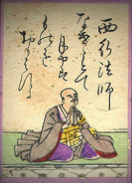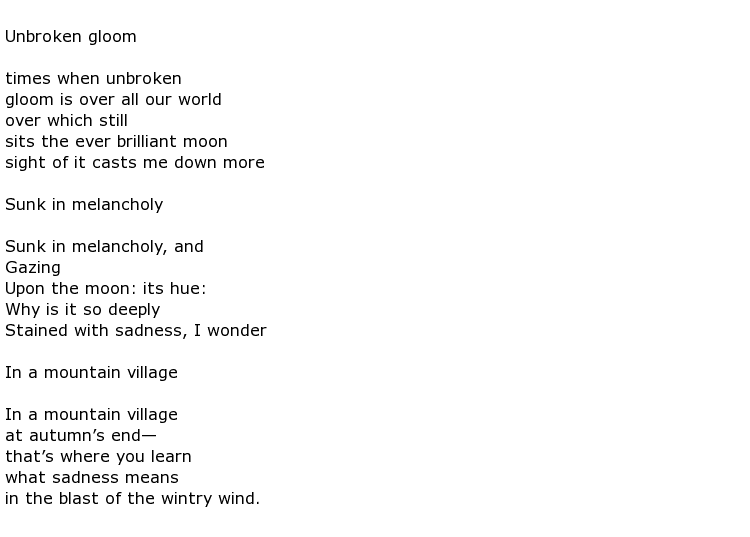 Saigyo was a 12th century Japanese poet who elected to become a Buddhist monk at the young age of 22 having lived a privileged life up to then. He originated from a noble family and, as an elite warrior of the Imperial guard, he had close connections with the Emperor both during his term of office and after retirement. He lived at a time of great upheaval in Japanese history as the Samurai warrior movement gradually overcame the old order of Japanese nobility. Saigyo’s transition from warrior to monk affected his style of writing to some degree. He effected a melancholic style although, unusually for a monk, he never lost touch with the material world, influenced still by his past Imperial court life.
Saigyo was a 12th century Japanese poet who elected to become a Buddhist monk at the young age of 22 having lived a privileged life up to then. He originated from a noble family and, as an elite warrior of the Imperial guard, he had close connections with the Emperor both during his term of office and after retirement. He lived at a time of great upheaval in Japanese history as the Samurai warrior movement gradually overcame the old order of Japanese nobility. Saigyo’s transition from warrior to monk affected his style of writing to some degree. He effected a melancholic style although, unusually for a monk, he never lost touch with the material world, influenced still by his past Imperial court life.
He was born Sato Norikiyo (佐藤 義清) in1118, in Kyoto, the son of a prominent Japanese nobleman. His family background gave him a lever into the inner sanctum of the Imperial Court and he served as a personal guard to Emperor Toba, continuing his devotion after the Emperor had retired. For reasons that have never become clear he gave up the life that he had known up to the age of 22 when he elected to become a Buddhist monk. His religious name became En’i (円位), and later on he adopted Saigyo as his pen name, this translating as “Western Journey”.
At that time many had considered Buddhism to be a declining faith with little hope of salvation for those followers who joined it. It is very likely that his frequent periods of solitude, often for fairly long stretches, will have affected Saigyo’s outlook on life which, despite being a monk, was still very outward looking. It has been said that he remained very much attached to the natural world and all its beauty. This was influenced, no doubt, by the long journeys that he took to places such as Northern Honshu. Such travels inspired other writers, a notable example being the classical Japanese poet Basho when he wrote Narrow Road to the Interior.
A lot of Saigyo’s life was spent living alone in such places as Mt Yoshino, Ise and Saga, all no doubt influencing his writing. Much of his classical “waka” poetry had an air of melancholy about it. He wrote in a style known as “Shin Kokin Wakashu” which was less subjective than Kokin Wakashu. It was a repetitive style, written using colloquialisms with fewer verbs and more nouns. The overall effect, mostly, was one of sombre presentation. Typical themes that Saigyo dwelled on were sabi (loneliness) and kanashi (sadness).
As mentioned above though Saigyo lived a somewhat unconventional life as a monk. While many wandered the land living the rustic life he never lost contact with the retired Emperor Suitoku and others of high society such as the first Shogun, Minamoto no Yoritomo. He recorded a lot of his experiences while working as a political coordinator, which continued after he became a monk.
Students of Japanese medieval literature have described the poetry of Saigyo as portraying a “suffering spiritual flower” and there is no doubt that his legend still burns brightly today, over 800 years after he lived.
Here are three short examples of his melancholia:

Saigyo died in 1190 at the Hirokawa Temple in Kawachi Province which is known nowadays as the Osaka Prefecture. He was aged 72.

